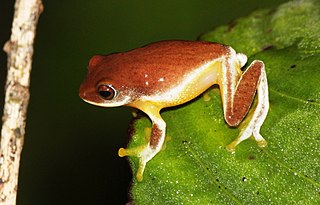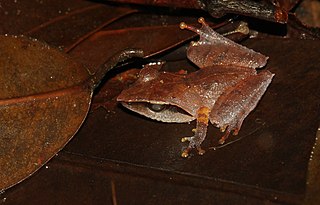
Pseudophilautus abundus is a species of frog in the family Rhacophoridae. It is endemic to Sri Lanka.

Pseudophilautus asankai, commonly called Asanka's shrub frog, is a species of frogs in the family Rhacophoridae.

Pseudophilautus auratus, commonly called golden shrub frog, is a species of frog in the family Rhacophoridae, endemic to Sri Lanka, where it lives in closed-canopy cloud forests between 513 and 1270 meters above sea level, including the Sinharaja World Heritage Site and Kanneliya Forest.

Pseudophilautus caeruleus, commonly called blue thigh shrub frog, is a species of frogs in the family Rhacophoridae. It is endemic to Sri Lanka.

Pseudophilautus cuspis, commonly known as sharp-snouted shrub frog, is a species of frogs in the family Rhacophoridae. It is endemic to Sri Lanka. It has been observed between 155 and 660 meters above sea level.

Pseudophilautus decoris, commonly known as the elegant shrub frog, is a species of frogs in the family Rhacophoridae. It is endemic to Sri Lanka.
Pseudophilautus dimbullae is an extinct species of frog in the family Rhacophoridae. It was endemic to Sri Lanka. It is only known from the holotype collected in 1933.
Pseudophilautus eximius is an extinct species of frog in the family Rhacophoridae. It was endemic to Sri Lanka. It is only known from the holotype collected in 1933.
Pseudophilautus extirpo, known as blunt-snouted shrub frog, is an extinct species of frog in the family Rhacophoridae. It was endemic to Sri Lanka. It is only known from the holotype collected in 1882. The specific name extirpo is Latin meaning "destroy" or "eradicate" and refers to the apparent extinction of this species.
Pseudophilautus folicola, known as leaf-dwelling shrub frog, is a species of frogs in the family Rhacophoridae.
Pseudophilautus halyi, known as pattipola shrub frog, is an extinct species of frog in the family Rhacophoridae. It was endemic to Sri Lanka. It is only known from the holotype collected in 1899. The specific name halyi honours Amyrald Haly, the first director of the Ceylon Museum, author of the "Natural History of Ceylon", and the collector of the holotype.
Pseudophilautus leucorhinus, also known as white-nosed shrub frog, pointed-nosed shrub frog, whitenose bubble-nest frog, and Marten's bush frog, was a species of frog in the family Rhacophoridae. It was endemic to Sri Lanka. It is only known from the holotype that was collected some time before 1856 from the indefinite type locality "Ceylon". Pseudophilautus wynaadensis from southwestern India has been considered conspecific with this species, but these species are now considered distinct.
Pseudophilautus limbus, also known as Haycock shrub frog, is a species of frogs in the family Rhacophoridae. It is endemic to southwestern Sri Lanka, including its type locality, Haycock Hill (Hiniduma) Forest Reserve. The specific name limbus, from the Latin for "edge" or "border", refers to the species originally having been known only from the border of the Haycock Hill Forest Reserve.

Pseudophilautus sordidus, commonly known as the grubby shrub frog is a species of frog in the family Rhacophoridae.

Pseudophilautus variabilis, also known as the variable bush frog or variable bubble-nest frog, is a species of frog in the family Rhacophoridae. This now extinct species was endemic to Sri Lanka. Despite extensive searches in recent times, it is only known from collections prior to 1858. The reasons for its disappearance are unknown but probably involve habitat loss.

Pseudophilautus viridis, or the dull-green shrub frog, is a species of frogs in the family Rhacophoridae. It is endemic to Sri Lanka and occurs in the central hills of south-central Sri Lanka.
Pseudophilautus zimmeri is an extinct species of frog in the family Rhacophoridae. It was endemic to Sri Lanka, where it was recorded from the vicinity of Galle. It is only known from the holotype that was used to describe the species in 1927. The specific name zimmeri honours Carl Wilhelm Erich Zimmer, a German zoologist. Common name Rumassala shrub frog has been coined for it.
Pseudophilautus pardus is an extinct species of Sri Lankan shrub frogs in the family Rhacophoridae. Despite extensive surveys in recent years, the species is known only from a collection made prior to 1858. The reason for its extinction is unknown but probably relates loss of forests.

Pseudophilautus is a genus of shrub frogs in the family Rhacophoridae endemic to the Western Ghats of southwestern India and to Sri Lanka where the majority of the species are found. Many of them are already extinct. On the other, some species believed to be extinct have also been rediscovered.
Pseudophilautus simba is a species of frogs in the family Rhacophoridae endemic to Sri Lanka. It is only known from its type locality in the Morningside Forest Reserve, adjacent to the Sinharaja Forest Reserve, near Rakwana, southern Sri Lanka.










